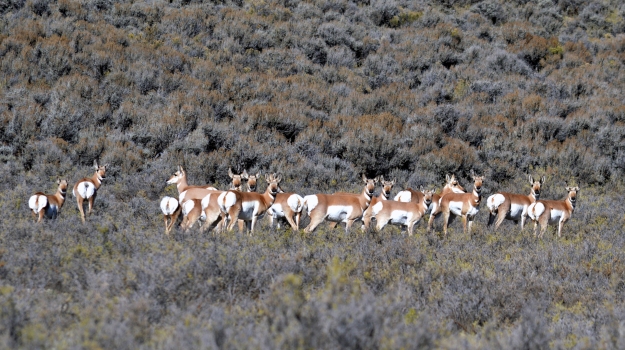
Chad was with me in a blind, and we had set up over a waterhole on public land that was a Hunter Management Area (HMA). There were three waterholes on this property. But from our scouting, we had learned that most hunters set up on the first two waterholes because they were the closest. The third water hole was farther back and required more walking. So we went to that one because nobody ever hunted this waterhole. We also learned that there was always a good herd of antelope coming to the waterhole.
We hiked in to the waterhole early, long before daylight, and set up our Ameristep blind about 50 yards from the waterhole. I feel very confident at taking a 60-yard shot with my Diamond bow. So, 50 yards was well within my range. We sat in the blind and watched the antelope all morning long. They would come near the waterhole but not close enough to take a shot. I had two different antelope tags. I had an antelope tag (with it I could take a buck or doe), and I also had a doe and a fawn tag. About noon, the weather was hot enough for the antelope to start coming in to water. But about an hour before the antelope started coming to water, we had a herd of cattle move in, and they bedded down all around us.
Our blind was set up to face the water. However, when Chad spotted this antelope doe coming to water from about 300 yards away, we zipped up the windows in the blind that we had opened to shoot through. If the antelope came to the water, the closed blind would keep us from being silhouetted. Next we turned our chairs around, so we had our backs to the water. Since the antelope was coming in, walking slowly, we had plenty of time to set up for me to take the shot. Chad and I switched chairs, because I prefer to sit on the right-hand side of the blind.
As the doe was walking in, Chad used his range finder. He whispered to me the distance that the doe was from our blind. He’d say, “She’s at 55 yards. She’s at 45 yards. She’s at 35 yards.”
When the doe got to 30 yards, she put her left leg forward, somewhat quartering to me. I then had the window open on that side and released my arrow, aiming right behind her shoulder. My broadhead passed through one lung and then the liver before exiting. As soon as the arrow hit the antelope, she wheeled and ran, and all the cows got up and started running. My antelope only went about 50 yards before she piled-up.
I went and found my arrow first. Then I continued to walk to the downed antelope. I was shooting a Muzzy four-bladed broadhead, and I had a really good blood trail. Once I reached the downed doe, I had an adrenaline rush that was hard to describe. When I took my first buck with my rifle, I can remember being excited. But the excitement and joy I felt at having an antelope that close (30 yards) and being able to take her with my bow was a far bigger adrenaline rush for me than taking my buck with my rifle at 80 yards.
I told Chad, “Okay, I'm hooked on bowhunting. What’s next?”
Day 3: Rena Parsons Loves Antelope Hunting
Tomorrow: The Antelope with the Heart-Shaped Horns



























